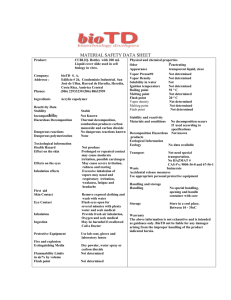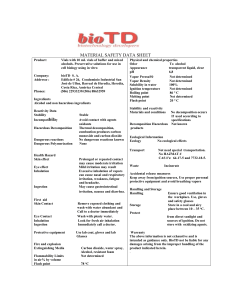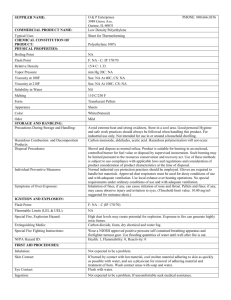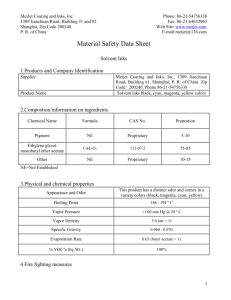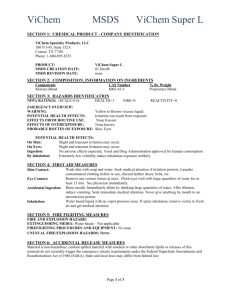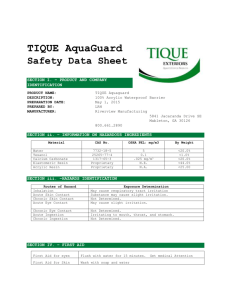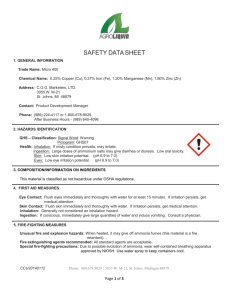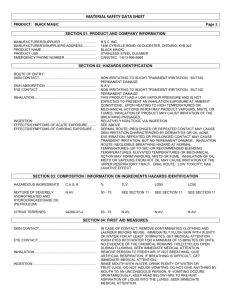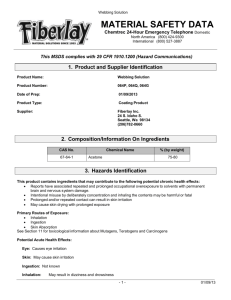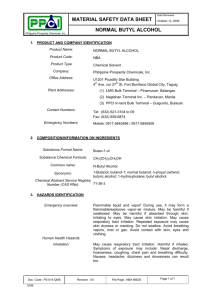MSDS-Nyalic
advertisement
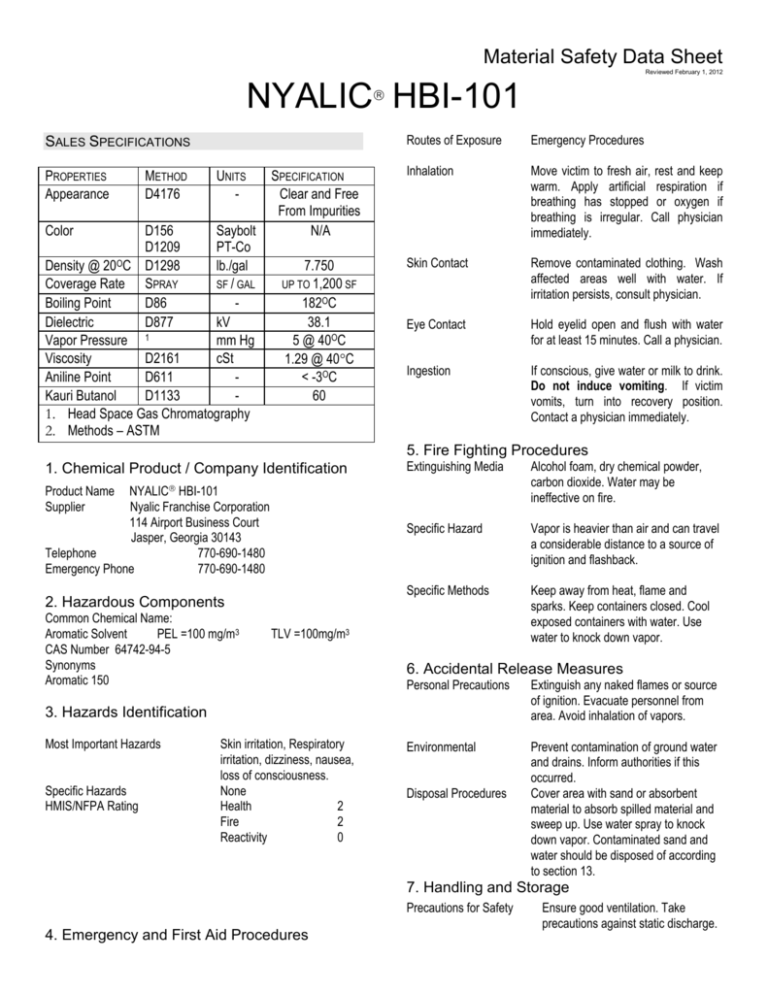
Material Safety Data Sheet Reviewed February 1, 2012 NYALIC HBI-101 SALES SPECIFICATIONS PROPERTIES Appearance METHOD D4176 UNITS - Color D156 Saybolt D1209 PT-Co Density @ 20OC D1298 lb./gal Coverage Rate SPRAY SF / GAL Boiling Point D86 Dielectric D877 kV Vapor Pressure 1 mm Hg Viscosity D2161 cSt Aniline Point D611 Kauri Butanol D1133 1. Head Space Gas Chromatography 2. Methods – ASTM SPECIFICATION Clear and Free From Impurities N/A 7.750 UP TO 1,200 SF 182OC 38.1 5 @ 40OC 1.29 @ 40C < -3OC 60 Routes of Exposure Emergency Procedures Inhalation Move victim to fresh air, rest and keep warm. Apply artificial respiration if breathing has stopped or oxygen if breathing is irregular. Call physician immediately. Skin Contact Remove contaminated clothing. Wash affected areas well with water. If irritation persists, consult physician. Eye Contact Hold eyelid open and flush with water for at least 15 minutes. Call a physician. Ingestion If conscious, give water or milk to drink. Do not induce vomiting. If victim vomits, turn into recovery position. Contact a physician immediately. 5. Fire Fighting Procedures 1. Chemical Product / Company Identification Extinguishing Media NYALIC HBI-101 Nyalic Franchise Corporation 114 Airport Business Court Jasper, Georgia 30143 Telephone 770-690-1480 Emergency Phone 770-690-1480 Alcohol foam, dry chemical powder, carbon dioxide. Water may be ineffective on fire. Specific Hazard Vapor is heavier than air and can travel a considerable distance to a source of ignition and flashback. Specific Methods Keep away from heat, flame and sparks. Keep containers closed. Cool exposed containers with water. Use water to knock down vapor. Product Name Supplier 2. Hazardous Components Common Chemical Name: Aromatic Solvent PEL =100 mg/m3 CAS Number 64742-94-5 Synonyms Aromatic 150 TLV =100mg/m3 6. Accidental Release Measures Personal Precautions Extinguish any naked flames or source of ignition. Evacuate personnel from area. Avoid inhalation of vapors. Environmental Prevent contamination of ground water and drains. Inform authorities if this occurred. Cover area with sand or absorbent material to absorb spilled material and sweep up. Use water spray to knock down vapor. Contaminated sand and water should be disposed of according to section 13. 3. Hazards Identification Most Important Hazards Specific Hazards HMIS/NFPA Rating Skin irritation, Respiratory irritation, dizziness, nausea, loss of consciousness. None Health 2 Fire 2 Reactivity 0 Disposal Procedures 7. Handling and Storage Precautions for Safety 4. Emergency and First Aid Procedures Ensure good ventilation. Take precautions against static discharge. Technical Measures Storage Conditions Store in accordance with all national, regional and local regulations pertaining to the storage, handling, dispensing, and disposal of combustible liquids. No smoking. Naked flames, hot elements or other ignition sources must not be present. Inhalation Practically non-toxic. May cause slight upper airway irritation. Ingestion Harmful if swallowed. (May be aspirated resulting in inflammation in lungs.) Store in tightly closed clearly labeled containers in cool well-ventilated area. Chronic Toxicity other effects. Carcinogenicity Mutagenicity Teratogenicity Incompatible Materials Strong oxidizing agents. Packaging Material Store in mild steel vessels. Ensure good ventilation. No vessel should be entered until it is gas-free. Workman outside should keep workmen inside the vessel under observation. Respiratory Not generally required. Gloves Viton, Nitrile, PVC Eyes Safety glasses with splash shields or face shield Other Measures Protective apron, long chemical resistant boots. sleeves, 9. Physical and Chemical Properties Appearance Odor Melting Point Boiling Point Flash Point Vapor Pressure Vapor Density Solubility in Water Viscosity V.O.C. Explosive Limits No significant neurotoxic, blood, kidney or Suspected (NTP & ACGIH) Data not Available Negative 12. Ecological Information 8. Exposure Controls and Personal Protection Engineering Measures Dermal LD50 >2000 Oral LD50 >2000 Colorless liquid Aromatic <-60OC 182OC 64OC (147OF) TCC 5 mm Hg 40OC >Air insoluble 1.29 @40OC cTs 677.7g/L .471 lb /100 sf. @1,200 sf / gal. UEL-11.7 LEL-1.8 Mobility Biodegradability Bioacculamation Ecotoxicity Data not Available Data not Available Data not Available Moderately Toxic 13. Disposal Procedures Disposal should be in accordance with local, regional or national regulations. Contaminated waste and packaging should be destroyed by incineration at an approved incinerator. If recovery of contaminated product is not possible, it should be destroyed by incineration. 14. Transportation Information Shipping Name Hazard Class Identification Number Packing Group Label Drum Placard Non-Bulk Placard Bulk Shipping Description Liquid Resin N/A N/A N/A N/A N/A N/A Liquid resin 15. Regulatory Information RCRA CERCLA SARA 311/312 SARA 313 Not Reportable Not Reportable Not Reportable Not Reportable 10. Stability and Reactivity 16. Other Information Stability Conditions to Avoid The information contained in this MATERIAL SAFETY DATA SHEET is provided pursuant to 29CFR 1910.1200 to convey information concerning the hazardous nature of the named product. The information supplied was compiled from the most reliable sources available at the time of preparation and in light of the most reasonable foreseeable exposure situations expected from the intended use of this product. The material(s) may present greater or lesser hazard exposure under other circumstances that are beyond the control of the manufacturer. Therefore it is imperative that all directions and warnings on the product label be read and closely followed. Stable High temperatures sources Strong Oxidizers and ignition Materials to Avoid Hazardous Decomposition Carbon oxides formed when burned. 11. Toxicological Information Eye Contact Severely Irritating Skin Contact Severely Irritating (Prolonged exposure may cause deffating resulting in dryness.)

